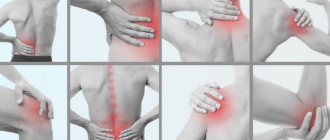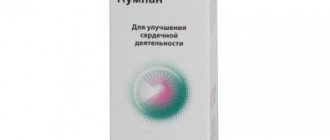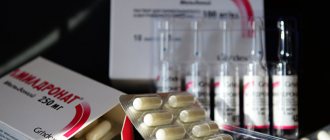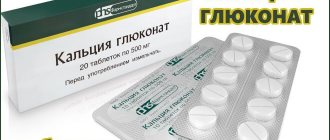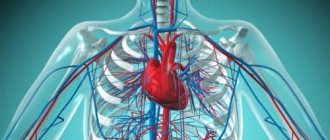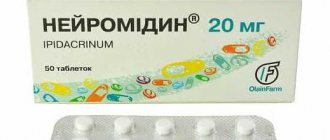Pharmacological properties of the drug Torvacard
Atorvastatin is a selective competitive inhibitor of methylglutaryl-coenzyme A (HMG-CoA) reductase, an enzyme that regulates the rate of conversion of HMG-CoA to mevalonate, a precursor of sterols (including cholesterol). In patients with homo- and heterozygous hereditary hypercholesterolemia, non-hereditary forms of hypercholesterolemia and mixed dyslipidemia, the use of atorvastatin reduces the total level of cholesterol, LDL cholesterol and apolipoprotein B. Atorvastatin also reduces the concentration of VLDL and TG. The drug reduces the level of cholesterol and lipoproteins in the blood plasma by inhibiting HMG-CoA reductase, cholesterol synthesis in the liver and increasing the number of LDL receptors on the surface of hepatocytes, which enhances the uptake and catabolism of LDL. Atorvastatin is rapidly absorbed after oral administration; the maximum concentration in the blood plasma is achieved after 1–2 hours. The rate of absorption and concentration in the blood plasma increase in proportion to the dose of the drug. The absolute bioavailability of atorvastatin is about 12%, and the systemic availability of HMG-CoA reductase inhibitory activity is about 30%. Atorvastatin is metabolized into ortho- and parahydroxylated derivatives and various β-oxidation products. In vitro, inhibition of HMC-CoA reductase by ortho- and para-hydroxyl metabolites is equivalent to inhibition by atorvastatin. Approximately 70% of the circulating inhibitory activity of HMG-CoA reductase belongs to the active metabolites. In vitro studies indicate the importance of hepatic metabolism of atorvastatin by cytochrome P450 3A4, corresponding to increased plasma concentrations of atorvastatin in people concomitantly receiving erythromycin, which is a known isoenzyme inhibitor. In vitro studies have also shown that atorvastatin is a weak inhibitor of cytochrome P450 3A4. The simultaneous use of atorvastatin and terfenadine, a compound that is mainly metabolized by cytochrome P450 3A4, did not significantly increase the concentration of terfenadine in the blood plasma. Therefore, it is unlikely that atorvastatin will significantly alter the pharmacokinetics of other cytochrome P450 3A4 substrates. Atorvastatin and its metabolites are partially excreted in bile after hepatic and extrahepatic metabolism. However, the drug probably does not pass through enterohepatic recirculation. The average half-life of atorvastatin from human plasma is about 14 hours. The half-life of the inhibitory activity of HMG-CoA reductase is approximately 20–30 hours due to the presence of active metabolites. Less than 2% of an oral atorvastatin dose is excreted in the urine.
pharmachologic effect
Belongs to the group of statins and has a lipid-lowering effect . Inhibits selectively and competitively the enzyme involved in cholesterol .
Triglycerides and cholesterol become components of atherogenic lipoproteins in the liver, after which they are transported to the periphery by the blood. By interacting with lipoprotein , they are converted into these lipoproteins.
Due to inhibition of HMG-CoA reductase, the level of lipoproteins and cholesterol in the blood decreases. The synthesis of LDL decreases and the activity of their receptors increases.
The drug is able to reduce the amount of LDL in cases of homozygous hereditary hypercholesterolemia
The medicine reduces cholesterol levels by 30-46%, atherogenic lipoproteins by 41-61%, triglycerides by 14-33% and increases the content of lipoproteins with antiatherogenic properties.
Indications for use of the drug Torvacard
Treatment of patients with elevated levels of cholesterol, LDL cholesterol, apolipoprotein B and TG; patients with primary hypercholesterolemia (heterozygous form of familial hypercholesterolemia and polygenic hypercholesterolemia) and mixed type (combined) hyperlipidemia corresponding to type IIa or type IIb according to Fredrickson, elevated TG levels (type IV according to Fredrickson) and patients with dysbetalipoproteinemia (type III according to Fredrickson), if the effect of following a special diet was insufficient. Therapy with the drug is carried out while continuing to follow a special diet. To reduce total cholesterol and LDL cholesterol in patients with homozygous hereditary hypercholesterolemia, if diet and other non-pharmacological therapeutic actions have not produced sufficient effect. For secondary prevention of myocardial infarction, reducing the risk of death or readmission for angina in patients with cardiovascular disease and/or dyslipidemia.
Reviews about Torvacard
Those reviews about Torvacard that are available on the forums allow us to conclude that the drug is quite effective. It is widely prescribed by cardiologists to lower cholesterol and protect patients from stroke and heart attack . After 1-2 months of use, a significant decrease in cholesterol levels is observed. Some women report a pleasant side effect: weight loss.
Among the disadvantages are that the cholesterol medicine can cause insomnia and an itchy rash on the body .
Use of the drug Torvacard
Before starting treatment with Torvacard, it is recommended to adhere to a standard diet that reduces cholesterol levels; This diet must be followed throughout the entire course of treatment with atorvastatin. Treatment usually begins with atorvastatin 10 mg once daily. Dosing is adjusted individually based on baseline LDL cholesterol levels compared to target LDL cholesterol levels and depending on the patient's response to therapy. Dosage is adjusted within 4 weeks of treatment, more if necessary. The maximum dose is 80 mg of atorvastatin per day. Primary hypercholesterolemia and mixed hyperlipidemia In most cases, a dose of 10 mg once daily is sufficient. The result of treatment is noticeable after 2 weeks, the stable maximum therapeutic effect is after 4 weeks. Homozygous hereditary hypercholesterolemia In a study where atorvastatin was used in patients with homozygous hereditary hypercholesterolemia, the majority of patients responded to treatment with atorvastatin 80 mg, producing a decrease in LDL cholesterol in more than 15% of cases (18–45%). Use in patients with renal failure Kidney damage does not affect either the plasma concentration or the effect of Torvacard on LDL cholesterol levels. Therefore, there is no need for dose adjustment in such patients. Use in children Information regarding the treatment of children is limited to the use of atorvastatin at a dose of up to 80 mg per day in 8 patients (children under 14 years of age) with homozygous hereditary hypercholesterolemia. As a result of the study, no clinical or biochemical abnormalities were noted in the patients. Use in elderly patients No differences have been identified between elderly patients and patients of other age groups regarding safety, effectiveness or achievement of treatment results. The tablet should be taken whole with plenty of water.
Torvacard price, where to buy
The cost of the drug in Russian pharmacies ranges from 276 to 320 rubles. for 30 tablets at a dose of 10 mg. The price of Torvacard 20 mg 90 tablets is on average 1025 rubles, and a package of 90 tablets with a dose of 40 mg costs 1286 rubles.
- Online pharmacies in RussiaRussia
- Online pharmacies in UkraineUkraine
- Online pharmacies in KazakhstanKazakhstan
ZdravCity
- Torvacard tablets p.p.o.
40 mg 90 pcs. Zentiva a.s./Saneka Pharmaceuticals a.s. RUB 1,439 order - Torvacard tablets p.p.o. 10 mg 90 pcs. Saneka Pharmaceuticals a.s.
RUR 596 order
- Torvacard tablets p.p.o. 40 mg 30 pcs. SanekaSaneka Pharmaceuticals a.s.
RUR 614 order
- Torvacard tablets p.p.o. 10 mg 30 pcs. Zentiva a.s./Saneka Pharmaceuticals a.s.
RUB 251 order
- Torvacard tablets p.p.o. 20 mg 30 pcs. Zentiva a.s./Saneka Pharmaceuticals a.s.
RUB 349 order
Pharmacy Dialogue
- Torvacard (tab.p.pl/vol.40mg No. 90)Zentiva as/Zentiva ks
RUB 1,487 order
- Torvacard (tab.p.pl/vol. 20 mg No. 30) Saneca
RUB 373 order
- Torvacard (tab.p.pl/vol. 10 mg No. 90) Saneca
RUR 683 order
- Torvacard (tab.p.pl/vol. 40 mg No. 90) Saneca
RUB 1,403 order
- Torvacard (tab.p.pl/vol. 10mg No. 30)Zentiva ks
290 rub. order
show more
Pharmacy24
- Torvacard Crystal 20 mg N90 tablets TOV Zentiva, Czech Republic
367 UAH.order - Torvacard Crystal 40 mg N30 tablets TOV Zentiva, Czech Republic
247 UAH order
- Torvacard Crystal 10 mg N90 tablets TOV Zentiva, Czech Republic
331 UAH. order
- Torvacard Crystal 10 mg N30 tablets TOV Zentiva, Czech Republic
112 UAH order
- Torvacard Crystal 20 mg N30 tablets TOV Zentiva, Czech Republic
96 UAH order
PaniPharmacy
- Torvacard tablets Torvacard 20 tablets. p/o 20 mg No. 90, Saneca Pharmaceuticals
345 UAH. order
- Torvacard tablets Torvacard 40 tablets. p/o 40 mg No. 30, Saneca Pharmaceuticals
267 UAH order
- Torvacard tablets Torvacard 20 tablets. p/o 20 mg No. 30, Saneca Pharmaceuticals
107 UAH order
- Torvacard tablets Torvacard 10 tablets. p/o 10 mg No. 30, Saneca Pharmaceuticals
111 UAH order
show more
Contraindications to the use of Torvacard
Hypersensitivity to any component of the drug; acute liver disease; liver failure; increased level of liver transaminases in the blood serum (more than 3 times); During pregnancy and breastfeeding. Due to the lack of experience in treating children with atorvastatin, it should be prescribed only by specialists for the treatment of serious forms of hypercholesterolemia in children, as well as homozygous forms of hereditary hypercholesterolemia, especially in the presence of a high risk of developing early atherosclerosis and its clinical complications.
Contraindications
According to the instructions, Torvacard is contraindicated for use:
- Against the background of active liver diseases;
- In case of liver failure with severity grades A and B on the Child-Pugh scale;
- Against the background of hereditary diseases such as lactose intolerance, lactase deficiency or glucose-galactose malabsorption;
- During pregnancy;
- During lactation;
- Women of reproductive age who do not use adequate methods of contraception;
- In pediatrics up to 18 years of age (due to insufficient clinical studies);
- In case of hypersensitivity to the active (atorvastatin) or auxiliary components included in Torvacard.
In addition, the use of Torvacard requires special caution:
- If you have a history of liver disease;
- For injuries;
- Against the background of alcohol abuse;
- Against the background of metabolic and endocrine disorders;
- In case of severe disturbances of water and electrolyte balance;
- Against the background of severe acute infections;
- With arterial hypotension;
- During major surgical interventions;
- For uncontrolled epilepsy;
- Against the background of skeletal muscle diseases.
Side effects of the drug Torvacard
The most common side effects (1% or more) noted during treatment with Torvacard were: general: headache, asthenia, abdominal pain, allergic reactions, back pain, chest pain, general fatigue; Gastrointestinal tract: dyspepsia, nausea, vomiting, anorexia, hepatitis, pancreatitis, cholestatic jaundice, flatulence, constipation, diarrhea; CNS: myalgia, paresthesia, peripheral neuropathy, dizziness, amnesia; musculoskeletal system: myalgia, myositis, myopathy, arthralgia, rhabdomyolysis; skin and mucous membranes: itching, alopecia, vesicular rash, urticarial rash, erythema multiforme, toxic epidermal necrolysis, Stevens-Johnson syndrome; genitourinary system: erectile dysfunction; metabolic and nutritional disorders: hypoglycemia, hyperglycemia, peripheral edema/edema, weight gain; hematological and lymphatic systems: thrombocytopenia.
Side effects
Nervous system: insomnia, headache, depression , sleep disorders , paresthesia , ataxia , neuropathies .
Digestive tract: stomach pain, dyspepsia , nausea and vomiting, stool disorders, changes in appetite, pancreatitis and hepatitis , jaundice .
Musculoskeletal system: pain in the joints and muscles, in the back, cramps in the leg muscles, myositis .
Allergic manifestations: urticaria , itching, anaphylactic shock , erythema multiforme, angioedema , Lyell's syndrome.
Laboratory abnormalities: changes in glucose , increased activity of liver enzymes and creatine phosphokinase in the blood.
Other manifestations may include swelling of peripheral tissues, chest pain, tinnitus, baldness, weakness, weight gain, impotence , secondary renal failure, and a decrease in platelet count.
Cholesterol pills in some cases led to depression , sexual dysfunction, rare cases of damage to the connective tissue of the lungs, and diabetes mellitus (development depends on risk factors - fasting glucose levels, arterial hypertension, body mass index, hypertriglyceridemia ).
Special instructions for the use of Torvacard
Treatment should be discontinued in acute conditions with a risk of renal collapse due to rhabdomyolysis, such as surgery, trauma, endocrine and electrolyte disturbances, hypotension, uncontrolled convulsions and acute infections. Effect on the liver As with other lipid-lowering substances of the same group, an increase in the level of liver transaminases was noted during treatment with atorvastatin (more than 3 times). Liver function must be determined before treatment and periodically throughout the course of treatment. If the activity of liver transaminases increases, patients should be monitored until the values normalize, and the dose of Torvacard should be reduced or treatment discontinued. It is not recommended to drink alcohol during treatment. The use of Torvacard does not affect the performance of work that requires increased attention, speed of mental and physical reactions (driving vehicles and machinery, working at height, etc.). Effect on the musculoskeletal system During treatment with Torvacard, myalgia may be noted. Patients should be warned about the possible occurrence of muscle pain, severe muscle weakness, sometimes with fever. In cases of increased creatinine phosphate kinase (CPK) levels, a definite or probable diagnosis of myopathy, treatment with Torvacard should be stopped immediately.
Interactions of the drug Torvacard
The risk of myopathy as a side effect of statins is higher with simultaneous use of: cyclosporine, fibric acid and its derivatives, macrolide antibiotics, antimycotic azoles or niacin. Amlodipine : with simultaneous use of 80 mg of atorvastatin and 10 mg of amlodipine, no changes in the pharmacokinetics of Torvacard were detected. Antipyrine: Since Torvacard does not alter the pharmacokinetics of antipyrine, interactions between other drugs metabolized by cytochrome are unlikely. Erythromycin/clarithromycin : simultaneous use of atorvastatin and erythromycin (500 mg 4 times a day) or clarithromycin (500 mg 2 times a day), known inhibitors of cytochrome P450 3A4, led to an increase in the plasma concentration of atorvastatin. Digoxin: Concomitant repeated administration of digoxin and atorvastatin 10 mg did not change the plasma concentration of digoxin at steady state. However, digoxin concentrations increased by approximately 20% when digoxin was coadministered with atorvastatin 80 mg once daily. It is necessary to monitor patients receiving Torvacard and digoxin in order to adjust the dose of digoxin. Oral contraceptives: Concomitant use of oral contraceptives containing norethisterone and ethinyl estradiol increased the AUC value of norethisterone by approximately 30% and ethinyl estradiol by 20%. This increase in concentration must be taken into account when choosing oral contraceptives for women receiving Torvacard. Cholestipol: Plasma concentrations of atorvastatin decreased with simultaneous use of atorvastatin and cholestipol (by approximately 25%), with a more pronounced lipid-lowering effect than with one drug alone. Antacids: When antacids containing magnesium and aluminum hydroxide were taken simultaneously with Torvacard, the plasma concentrations of atorvastatin and its active metabolites decreased by approximately 35%, but the decrease in LDL cholesterol levels did not change. Warfarin: Comparative interaction studies between warfarin and atorvastatin did not reveal any clinically significant interactions. Phenazone: Since atorvastatin does not affect the pharmacokinetics of phenazone, there are no interactions with other drugs metabolized through the same cytochrome isoenzymes. Cimetidine: When studying the combined use of cimetidine and atorvastatin, no interaction was observed. Azithromycin: The plasma concentration of atorvastatin is not affected by the simultaneous use of atorvastatin (10 mg once daily) and azithromycin (500 mg once daily). Terfenadine: Concomitant use of atorvastatin and terfenadine did not cause a clinically significant effect on the pharmacokinetics of terfenadine. Protease inhibitors: simultaneous use of atorvastatin with protease inhibitors that inhibit the effect of cytochrome P450 3A4 is accompanied by an increase in the concentration of atorvastatin in the blood plasma. Concomitant therapy: During clinical studies, Torvacard was used concomitantly with antihypertensive agents and estrogen replacement drugs without significant interaction effects. Interaction with specific agents has not been studied.
Release form and composition
Dosage form – film-coated tablets: biconvex, round, almost white or white (10 pieces in blisters, 3 or 9 blisters in a cardboard pack).
Active substance: atorvastatin calcium, its content in 1 tablet in terms of atorvastatin is 10, 20 or 40 mg.
Additional components: low-substituted hyprolose, lactose monohydrate, microcrystalline cellulose, colloidal silicon dioxide, croscarmellose sodium, magnesium stearate, magnesium oxide.
Shell composition: titanium dioxide, macrogol 6000, talc, hypromellose 2910/5.
Torvacard overdose, symptoms and treatment
There is no specific treatment for atorvastatin overdose. In case of overdose, symptomatic and supportive therapy is carried out (gastric lavage, administration of activated charcoal or laxatives). If myopathy is noted with the further development of rhabdomyolysis and acute renal failure (a rare but serious side effect), immediate discontinuation of the drug and the administration of diuretics and sodium bicarbonate are required. Rhabdomyolysis can lead to hyperkalemia; in this case, intravenous administration of calcium chloride or calcium gluconate, infusion of glucose with insulin, and ion exchange agents are necessary to normalize potassium metabolism. Since atorvastatin binds to plasma proteins, hemodialysis does not lead to a significant decrease in the concentration of the drug in the blood plasma.
Pharmacodynamics and pharmacokinetics
In the blood, the maximum concentration of the drug occurs within 60-120 minutes. Eating reduces the duration of absorption, but the reduction in cholesterol is comparable to that without food. When used in the evening, the concentration of the drug is lower than when taken in the morning.
98% bound to blood proteins. Metabolized in the liver to form active metabolites.
It is excreted in bile, the half-life is 14 hours. The effectiveness of the drug is maintained due to active metabolites for up to 30 hours. It is not excreted during hemodialysis.


